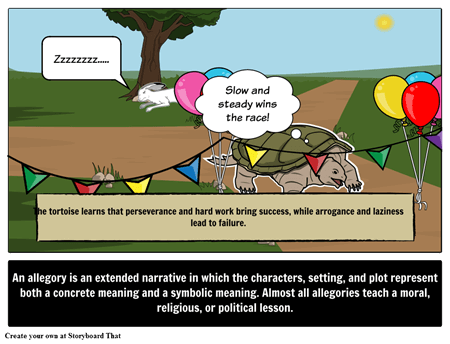Welcome to Storyboard That's Picture Encyclopedia of Literary Terms! We have put together a collection of storyboards to help you better understand various literary elements. In addition to the storyboards, we have included detailed definitions and examples for each of the key literary terms. Check out the list below! Create your own storyboard to expand your understanding of literary devices!
Click on any of the terms below to get started!
How Tos about {lmk:100539}
Engage students with interactive storyboard activities for literary terms
Incorporate collaborative group work by assigning each student a different literary term to illustrate using storyboards. This promotes deeper understanding and creativity.
Connect storyboards to reading assignments for enhanced comprehension
Pair each reading assignment with a storyboard task where students visually represent key literary elements from the text. This helps students apply their knowledge in a tangible way.
Assess understanding of literary terms through peer presentations
Invite students to present their storyboards to the class and explain their chosen literary term. Use peer feedback to reinforce learning and correct misconceptions.
Differentiate instruction using scaffolded storyboard templates
Provide storyboard templates with varying levels of support for students of different abilities. This ensures all learners can participate and succeed in exploring literary terms.
Frequently Asked Questions about {lmk:100539}
What is a picture encyclopedia of literary terms?
A picture encyclopedia of literary terms is a visual resource that explains key literary elements using images and definitions, helping students and teachers quickly understand concepts like metaphor, symbolism, and plot structure.
How can teachers use storyboard examples to teach literary devices?
Teachers can use storyboard examples to visually demonstrate literary devices, making abstract concepts more concrete. Students can create their own storyboards to reinforce understanding and encourage creative learning.
Why are visual aids important in learning literary terms?
Visual aids help learners grasp literary terms by providing clear, memorable examples. Pictures can clarify complex ideas and make lessons more engaging for students of all ages.
What are some common literary elements explained in the encyclopedia?
The encyclopedia covers common literary elements such as plot, character, setting, theme, conflict, symbolism, and figurative language, each illustrated with definitions and visual examples.
How do I create my own storyboard to learn literary terms?
To create your own storyboard, use the online storyboard creator tool. Pick a literary term, illustrate it with scenes and characters, and add your own definition and example to deepen your understanding.
Allegory - Motif
- Allegory
- Allusion
- Antagonist
- Archetype
- Character vs. Character
- Character vs. Nature
- Character vs. Society
- Character vs. Technology
- Characterization
- Direct Characterization
- Dramatic Irony
- Dynamic Character
- External Conflict
- Figurative Language
- Flashback
- Foil
- Foreshadowing
- Indirect Characterization
- Internal Conflict
- Irony
- Literary Conflict
- Metaphor
- Mood
- Motif
Narrator - Verbal Irony
Bring This to Your Classroom!
Our digital picture encyclopedia resources have easy to understand information with a visual in order to activate understanding and retention. Storyboard That is passionate about creating resources that inspire children to be storytellers, and we want students of all ages to have the ability to showcase what they have learned.

- Assign a term/person/event to each student to complete their own storyboard.
- Create your own picture encyclopedia of a topic you are studying.
- Create a picture encyclopedia of the people in your class or school.
- Post storyboards to class and school social media channels.
- Copy and edit these storyboards and encyclopedia pictures and use them as references or visuals.
© 2025 - Clever Prototypes, LLC - All rights reserved.
StoryboardThat is a trademark of Clever Prototypes, LLC, and Registered in U.S. Patent and Trademark Office

